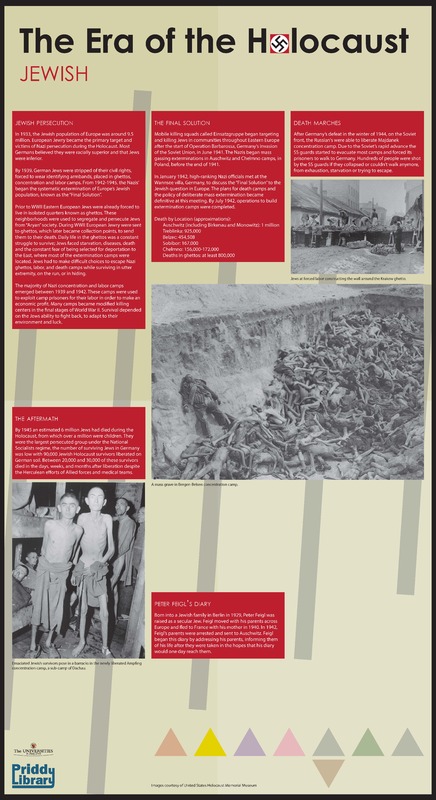Jewish Prisoners
JEWISH PERSECUTION
In 1933, the Jewish population of Europe was around 9.5
million. European Jewry became the primary target and
victims of Nazi persecution during the Holocaust. Most
Germans believed they were racially superior and that Jews
were inferior.
By 1939, German Jews were stripped of their civil rights,
forced to wear identifying armbands, placed in ghettos,
concentration and labor camps. From 1942-1945, the Nazis’
began the systematic extermination of Europe’s Jewish
population, known as the “Final Solution”.
Prior to WWII Eastern European Jews were already forced to
live in isolated quarters known as ghettos. These
neighborhoods were used to segregate and persecute Jews
from “Aryan” society. During WWII European Jewry were sent
to ghettos, which later became collection points, to send
them to their death. Daily life in the ghettos was a constant
struggle to survive; Jews faced starvation, diseases, death
and the constant fear of being selected for deportation to
the East, where most of the extermination camps were
located. Jews had to make difficult choices to escape Nazi
ghettos, labor, and death camps while surviving in utter
extremity, on the run, or in hiding.
The majority of Nazi concentration and labor camps
emerged between 1939 and 1942. These camps were used
to exploit camp prisoners for their labor in order to make an
economic profit. Many camps became modified killing
centers in the final stages of World War II. Survival depended
on the Jews ability to fight back, to adapt to their
environment and luck.
THE FINAL SOLUTION
Mobile killing squads called Einsatzgruppe began targeting
and killing Jews in communities throughout Eastern Europe
after the start of Operation Barbarossa, Germany’s invasion
of the Soviet Union, in June 1941. The Nazis began mass
gassing exterminations in Auschwitz and Chelmno camps, in
Poland, before the end of 1941.
In January 1942, high-ranking Nazi officials met at the
Wannsee villa, Germany, to discuss the “Final Solution” to the
Jewish question in Europe. The plans for death camps and
the policy of deliberate mass extermination became
definitive at this meeting. By July 1942, operations to build
extermination camps were completed.
Death by Location (approximations):
Auschwitz (including Birkenau and Monowitz): 1 million
Treblinka: 925,000
Belzec: 454,508
Sobibor: 167,000
Chelmno: 156,000-172,000
Deaths in ghettos: at least 800,000
DEATH MARCHES
After Germany’s defeat in the winter of 1944, on the Soviet
front, the Russian's were able to liberate Majdanek
concentration camp. Due to the Soviet’s rapid advance the
SS guards started to evacuate most camps and forced its
prisoners to walk to Germany. Hundreds of people were shot
by the SS guards if they collapsed or couldn’t walk anymore,
from exhaustion, starvation or trying to escape.
THE AFTERMATH
By 1945 an estimated 6 million Jews had died during the
Holocaust, from which over a million were children. They
were the largest persecuted group under the National
Socialists regime, the number of surviving Jews in Germany
was low with 90,000 Jewish Holocaust survivors liberated on
German soil. Between 20,000 and 30,000 of these survivors
died in the days, weeks, and months after liberation despite
the Herculean efforts of Allied forces and medical teams.
PETER FEIGL’S DIARY
Born into a Jewish family in Berlin in 1929, Peter Feigl was
raised as a secular Jew. Feigl moved with his parents across
Europe and fled to France with his mother in 1940. In 1942,
Feigl’s parents were arrested and sent to Auschwitz. Feigl
began this diary by addressing his parents, informing them
of his life after they were taken in the hopes that his diary
would one day reach them.
